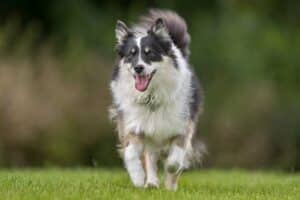People have long wondered whether dogs can be albino — they can be! While dogs can be albino, they don’t have the quintessential snow-white fur and ruby-red eyes many people associate with albinism. Because of that, until recently, people disagreed over whether albino dogs even existed.
But they do exist. Albino dogs have light cream to white fur and light blue to almost white eyes. There’s no such thing as an albino dog breed, but albino dogs are found more often in some breeds than others, including Doberman Pinschers, Pugs, Pekingese, Lhasa Apsos, Pomeranians, and Dachshunds, among others. Albino dogs can be confused with “double merle,” or with dogs with light cream or white coats.
So how do you know if your dog is albino? Albino dogs never have patches of pigment anywhere on their hair or skin, and they have bluish eyes, pink eye rims, pink lips, pink paw pads, and pink noses. It may appear at times that albino dogs have red eyes. However, the reason for that is albino dogs are also missing the pigmented layer of reflective tissue at the back of the eye, so that if a light shines in the eyes, they reflect red from the blood vessels there.
Albino dogs are uncommon because most breeders who are concerned with good health avoid producing them. Albino dogs require special care to avoid health problems that result from their lack of pigment.
The Case of the Albino Doberman
Doberman Pinschers are the breed most identified with albinism, and they were the first breed in which an albino gene was identified. The story goes back to 1976, when a white Doberman Pinscher named Padula’s Queen Sheba was born — to two black and rust parents. Sheba was bred to produce more white Dobermans. Since then, several thousand Dobermans, many of them white, have descended from Sheba.

Curious about the genetics behind these puppies, the Doberman Pinscher Club of America (DPCA) acquired two white dogs for test matings. Bred to colored Dobermans, the white dogs produced only colored offspring. This was consistent with a recessive mode of inheritance. In recessive inheritance, two copies of a gene (one inherited from each parent) must be identical in order for the gene to produce its trait. If only one copy is present, the other, “dominant” copy’s traits prevail. Other crosses were also consistent with Doberman white being caused by a recessive gene at a different genetic location than the ones that caused the fur to be either black versus red and either full strength versus diluted. A dog with two copies of the white gene (aa) masked any color that would otherwise have been expressed. These genetic modes of inheritance were consistent with what geneticists knew about the genetics of albinism in other species.
Designations and DNA Tests for Albino Dobermans
DPCA members noted that these white Dobermans were very sensitive to bright light and were prone to develop skin tumors as they aged — two health problems commonly associated with the lack of pigment caused by albinism. Because of this, they were concerned that the trait and its accompanying health concerns could become widespread. Had the albino gene been dominant, breeders could have identified every dog carrying the gene and avoided breeding them. But because it’s a recessive gene, it could be passed on, generation after generation, masked by the dominant gene, until two carriers were bred to one another. When that happened, there would be on average a 25% chance of producing another albino.
To avoid this, the DPCA requested the AKC to place a special designation on the AKC registration number of every Doberman that descended from Sheba’s sire or dam. Both needed to be noted, since both had to have been carriers of the recessive gene in order to have produced all-white Sheba. As such, each of their offspring had a 50% chance of inheriting the recessive gene and passing it down to their descendants. The AKC agreed, and to this day every such descendant is designated with an AKC number that begins with “WZ.” These dogs are known as “Z-factored,” and they’re said to be on “the Z-list,” which now contains more than 20,000 Dobermans. Breeders can still use the Z-list to ensure they are not introducing the albino gene into their bloodlines.

In 2014, researchers were able to identify the actual genetic variant that causes albinism in Dobermans. To understand the mutation, you need to know that albinism comes in many forms. More than 60 different genetic mutations in various species are known to cause albinism, often with only slightly different from one another. The gene responsible for Doberman albinism is the same mutation that causes a type of albinism called oculocutaneous albinism Type 4 (OCA4) in humans, Bengal tigers, horses, and lowland gorillas. The oculocutaneous albinism mutation is a 4,081 base pair deletion of the SLC45A2 gene, which means that the gene is missing part of its normal components. Now a DNA test can determine if a Doberman carries that mutation. This genetic variant may be present in other breeds, but more validation is needed to confirm.
Different Genes that Cause Albinism in Dogs
For example, another recent study found a different genetic variant (but in the same SLC45A2 gene) that causes albinism in Lhasa Apsos, Pekingese, and Pomeranians. A DNA test is available for the Lhasa Apso. The authors believe that this mutation for oculocutaneous albinism might be responsible for albinism in all small, long-haired breeds, possibly due to interbreeding at one time by breeders who found the trait attractive.
An albino Pug in the same study did not carry the same mutation as these breeds or Dobermans, and an albino Bullmastiff in a separate study also carried a separate mutation in this same gene. This means there are at least three and possibly more mutations that cause albinism in dogs.
Other dog breeds with albinos include Shih Tzu, Poodles, Beagles, Pugs, Dachshunds, and doubtless many others. It’s possible some of these breeds might carry the same genetic variants already identified in other albino dogs, but not necessarily.

Because albino dogs exist in so many unrelated breeds, you might think that these genetic variants are ancient mutations that have been around before individual breeds, or even domesticated dogs, but there is no evidence of this currently. Note that there’s never been a verified case of an albino wolf, although it’s possible such an animal may not have survived. In humans, the genetic variant for the most common type of albinism (OCA2) appears to have arisen during humankind’s development in Africa in ancient times, explaining why this type of albinism is much more common in Africa than elsewhere.
We don’t yet know how widespread the various mutations are for canine albinism, but as scientists are constantly learning more about DNA and breeds, that answer may come. Another explanation could be that genes responsible for pigment just mutate a lot, which might explain why albinism is so widespread throughout the entire animal kingdom, especially in mammals. Breeders need to test for the appropriate test in each breed by checking the specific genetic variant, not just the gene. If a dog appears albino and none of the known genetic variants are present, contact AKC DNA.
Albino Dogs and Health Problems
Unfortunately, albinism in dogs and other species also means health problems caused by the lack of protective pigment in the eye and skin. Researchers have found that albino Dobermans have significantly more eye and skin tumors than non-albinos. But it’s not all bad news: most albino dogs live the normal lifespans for their breed. There’s no evidence that albino dogs are more prone to deafness, as some people believe. Deafness in dogs can be related to having lots of white fur, but a different mechanism appears to be responsible in those dogs. Albino dogs don’t have increased behavioral problems, as long as you make allowances for the fact they may not be able to see well in bright light.
Eye Problems in Albino Dogs
The pupil, which is the opening in the iris that gets bigger and smaller to let more or less light in according to light levels, is relatively useless in albino dogs because of the lack of pigment in the iris. The iris, which is the colored part of the eye, allows most of the light to travel right through it, so it makes no difference if the pupil is open wide or constricted to its smallest size. It’s like going out in bright sunlight after the eye doctor puts drops in your eye to dilate your pupil — the light hurts! An albino dog is constantly dealing with this situation, so they typically have to squint when in bright light.
When the light receptors at the back of the eye are bombarded with bright light, they use up the chemicals that allow them to signal to the brain. That’s why you can’t see in a normally lit room when you come in from the bright outdoors. An albino dog will consistently face this situation, so they actually have a hard time seeing even in normal lighting.
Vision Problems in Albino Dogs
Albino dogs never have an effectively constricted pupil. This means that they likely have poorer visual acuity, which means their vision isn’t as sharp. And because they are missing the reflective layer behind the retina that normally helps dogs see in the dark, they probably have poorer night vision. In humans and some other species, albinism has been associated with abnormal development of structures within the eye. It has also been associated with nerve routing from the eye to the visual centers of the brain (which affects binocular vision), but no such studies have been done in albino dogs.
Skin Problems in Albino Dogs
Another function of pigment is to protect parts of the body from the damaging ultraviolet (UV) rays from the sun. An albino dog’s eye and skin cannot do this because they don’t have the necessary pigment. UV light causes aging and damage to the eye’s lens and internal structures, including the lens and retina, and to the body’s skin. Essentially, an albino dog’s skin is more exposed to these UV rays because there is no protective later to help shield them. This can mean that they are more prone to developing metastatic skin cancers.
Living With an Albino Dog
If they don’t have any sort of cancers or tumors because of their lack of pigmentation, albino dogs can live to meet their breed’s natural lifespan. But albino dogs do require extra care. They should wear some sort of covering when out in the sun, and sun protectors with the highest UV rating possible should be applied everywhere that can’t be covered, especially on bare skin like the nose and belly. Some people fit their dogs with protective goggles with sunglass lenses. Better yet, avoid the sun and play outside at night.
Despite the need for these special precautions, albino dogs can make wonderful companions. Although they can’t compete in AKC Conformation shows, several have excelled in AKC companion sports. Albino Doberman “Sprite” for example, achieved AKC Utility Dog, Rally Excellent, Masters Agility, Masters Agility Jumpers, and Masters Jumpers Bronze level titles — all advanced degrees in Obedience and Agility. If you take care of your albino dog’s unpigmented skin and sensitive vision, there’s no reason why they can’t do the same things as most other dogs.








